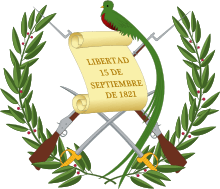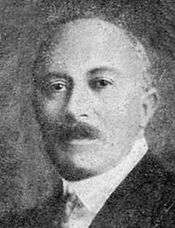April 1920 Guatemalan presidential election
Indirect presidential elections were held in Guatemala on 8 April 1920. After two decades of repression and dictatorial rule, political opponents of Manuel Estrada Cabrera organized the Unionist Party (PU) in 1919.[1] Led by Conservatives tied to the landed oligarchy, the Unionists also attracted support among the urban proletariat, artisans, students, and industrialists.[2]
| ||||||||||||||||||||
| ||||||||||||||||||||
| ||||||||||||||||||||
 |
|---|
| This article is part of a series on the politics and government of Guatemala |
|
Executive
|
|
Legislature
|
| Judiciary |
|
Administrative divisions |
|
|
|
In January 1920 the Unionists allied with dissident Liberals in the legislature led by Adrian Vidaurre.[3] Toward the end of March 1920 the Unionists began to pressure the National Legislative Assembly to impeach Estrada Cabrera.[4] Even those who had benefitted from his rule accepted that Cabrera should step down.[5] On 8 April he was declared insane and no longer capable of governing the country by members of the Legislative Assembly. They then voted to replace him with Carlos Herrera y Luna (36 out of 42 voted for him). On 9 April Cabrera ordered troops still loyal to him to bomb the Unionist-held Guatemala City, but on 15 April Congress accepted his resignation.[6]
References
- Casey, Dennis Floyd (1979) Indigenismo: the Guatemalan experience Lawrence: University of Kansas. Unpublished dissertation, p106
- Dosal, Paul J (1993) Doing business with the dictators: a political history of United Fruit in Guatemala, 1899-1944 Wilmington: Scholarly Resources, p95
- Dosal, p96
- Pitti, Joseph A (1975) Jorge Ubico and Guatemalan politics in the 1920s Albuquerque: University of New Mexico. Unpublished dissertation, p26
- Grandin, Greg. The last colonial massacre: Latin America in the Cold War. Chicago: University of Chicago Press. 2004. Pp. 27.
- Pitti, p27
Bibliography
- Calvert, Peter. Guatemala : a nation in turmoil. Boulder: Westview Press. 1985.
- Díaz Romeu, Guillermo. “ Del régimen de Carlos Herrera a la elección de Jorge Ubico.” Historia general de Guatemala. 1993-1999. Guatemala: Asociación de Amigos del País, Fundación para la Cultura y el Desarrollo. Volume 5. 1996.
- Holden, Robert H. Armies without nations: public violence and state formation in Central America, 1821-1960. New York: Oxford University Press. 2004.
- Jiménez, Ernesto Bienvenido. Ellos los presidentes. Guatemala: Editorial José de Pineda Ibarra. 1981.
- Krehm, William. Democracia y tiranias en el Caribe. Buenos Aires: Editorial Parnaso. 1957.
- Rendón, Catherine. “El gobierno de Manuel Estrada Cabrera.” Historia general de Guatemala. 1993-1999. Guatemala: Asociación de Amigos del País, Fundación para la Cultura y el Desarrollo. Volume 5. 1996.
- Schlewitz, Andrew James. The rise of a military state in Guatemala, 1931-1966. New York: New School University. Unpublished dissertation. 1999.

